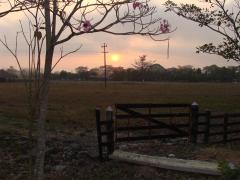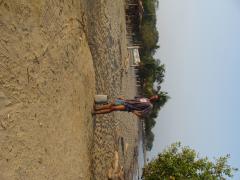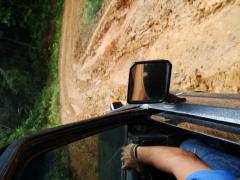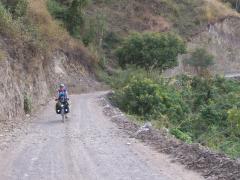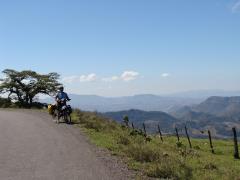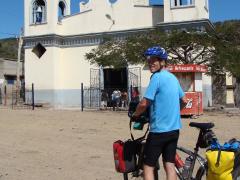nancy's blog
Riding the lowlands of Colombia
If Columbia has always been a mystery to you as it has been to me let me give you a brief impression of our 3 day out ride. (yes, Nancy can be brief once in awhile)
Southwest of Cartagena along the coastal roads, it is the land of grazing hotland cows that are shiny gray and look like water buffaloes. The land is mostly dry and more dry with some huge trees spread out across the flatlands. Mostly is hot, hot and hotter. The temperature read 112 degrees fahrenheit as we rode (that was with the thermometer in the sun). The night cooled down to 86 degrees at 10:00 at night. Two hours after sunrise and two hours before sunset the sky is on fire with orange hazy humidity. The roads are great to ride, because on our backroads route there are more cyclists than cars, and many motorcycles, and a few buses, who all work well together sharing the highways and byways equally. It belongs to everyone. What a unique feeling to ride without the fear of being squashed. So far, we've had lots of respect from all motorized traffic. (We get back to the main highway in a couple of days. Hope our report is the same.) And people call us amigos instead of gringos. read more here... lee mas aquí... »
Panama to Cartagena, Colombia
Here is the story of our trip from Panama City to Cartagena, Columbia – starting in a 4x4 vehicle from Panama City to Carti, Panama and then taking the 100´ sailboat the Stahlratte to Cartagena.
We got picked up at at the Hotel California in Panama City at 5:15 in the morning and threw our bikes and gear up on the roof rack and squeezed in the back with 7 other passengers, all who were going on the same sailing trip from Panama to Columbia. I, more than Randy, thought it would be great fun to take a long sailing trip. I have always thought I should try it to see if I might want to sail around the world after I finish biking half way around the world.
As we rode in the back of the jeep I was very grateful to be in the truck and not trying to ride, push or throw my bike along this route. The road was flat at first and paved until the turn off at El Llano, but that’s where the real road started. Other cyclists before us have ridden this and described this section as having 100 hills and many 20% grades. It was very impressive and I think I would have died trying to ride it. It had been raining the night before and the rain carved eroded mud-lined tracks that zigzag down the steepest parts. The truck would slide from side to side trying to find a hold in the red mush we sloshed through. Other trucks ahead and behind us also had moments of uncontrolled maneuvering. One 4x4 vehicle we passed parked at the creast of a hill was overheating from the taxing travels through the Kuna jungle. After we arrived at the end of the road, a trip which took about 4 hours, I was very happy with our decision not to have ridden this ride. Our newly cleaned bikes appreciated it too. read more here... lee mas aquí... »
Nancy's return back to Panama
I am back in Panama after spending 3 weeks playing nurse for my dad. I want to first thank all of you who wished my father a quick return to good health. I am positive all the warm wishes aided in his return to health and also return back to his own home in Boston.
It is amazing to see how sick he was and how his body was able to heal and how far he has come. My family gave me the nickname Nurse Ratchett, who was the nurse in the movie "One Flew Over the Cuckoos Nest". When I arrived to California, my brother Mark and I drove to the rehab center to bring my dad home to my brothers home. I had a 2 hour crash course on how to do more medical stuff than I ever thought possible.
Two days later my brother left for the week on a business trip. I was left to take care of my very sick dad. When he was released from the rehab center, he was on oxygen, insulin dependent, in a wheel chair, 15 different medicines, had bedsores and was still very sick. Every day he made incredible strides toward health. When I left him on April 6th, he was using a cane (when he remembered), no insulin, oxygen, and took 12 medicines a day and was in awesome health. My goal was to get him health so he could return back home in Boston. He is going home on the 10th with my brother Dan. I hope my dad continues to thrive when he returns back to his own home and does not have Nurse Ratchett telling him what to do.
It is very hot here in Panama and I can not wait to get to the highlands again where it is 30 degrees cooler. I have been having such intense hot flashes, I just about drowned myself. read more here... lee mas aquí... »
Nancy's tips on riding the roads of Latin America
I wrote this in response to a letter of consternation from one of the few other women (and one of the very few other "mature" couples) riding a route like ours in Latin America. It seemed worth while sharing with you, my management technics on how I managed riding the roads of Latin America.
This intrepid rider sent a note saying that the roads of Mexico were freaking her out so she was hopping on buses to avoid certain stretches and was having a difference of opinion about the risk level of the roads with her husband. Here is my response, such as it is:
First of all, I do think you have great amount of courage and smarts and capabilities. I admire you on many accounts. Anyone that has ridden Copper Canyon the way you you did has my admiration. If I knew you better, I might be more comfortable telling you that you have balls.
In retrospect, after riding through Mexico, Guatemala, Honduras, Nicaragua, and Panama, my thoughts about riding in Mexico are that it is a difficult country to ride in, especially as you get closer to the cities. The bigger the city, the more aggressive the drivers, and less room for mistakes.
The saint of San Rafael
On the struggle out of the valley of San Marcos, a truck stopped and offered us a lift. It was driven by an Italian Catholic priest in traditional robes and two sisters with similar brown habits. They smiled so nicely as they told me about their lovely town of San Rafael and their special church. They encouraged me to visit San Rafael which I did the next day.
I took a bus out to San Rafael and did agree that is was a wonderful village. I got a private tour of Tepeac by the groundskeeper who had great love for this special place. According to an article published in the Nica News 21 (March 1999) “The most outstanding figure in the history of San Rafael is the Italian priest, Father Odorico D'Andrea. From his arrival in 1953 to his death in 1996, Father Odorico achieved virtual sainthood among the people of San Rafael and the surrounding communities. His image, a smiling, warm, obviously kind man in plain brown robes, can be seen in nearly every home, business and vehicle in the town. "It's so sad," said one community member, "that you weren't here to know him." Among his achievements are a formidable health clinic, a library, several neighborhoods for the poor, and the beautifying of the church.
The latter feat is truly impressive. Pastel-colored windows admit a calming light in which to view the many bright murals, bas-reliefs and shrines. read more here... lee mas aquí... »
The ride from San Marcos to Jinotega
Let me take a moment and tell you about one of the villages we rode through on the way from Estelí to Jinotega, Nicaragua this week. San Marcos is a strange little village where everything has been built around a lone church. The houses in the village form a huge empty dirt circular void around the church with nothing in between. It reminded me of an old ghost town but there was people in front of every house, just sitting and watching the strange gringos ride through their village.
It was around high noon as we rode in. In the bell tower were two young boys ringing the church bell, calling to everyone that the funeral service was about to begin. The only restaurant closed up just seconds before we rode up (probably because of the funeral). Everyone was strolling toward the church and those that were not just sat and stared at us, hungry we rode on to another part of the village that had promise for lunch time nourishment and knowing that we had some hard climbs ahead. With just a small printed sign above a door, I stopped to ask where we could find something to eat. An older man rushed off to find his aging wife. Bingo, there was some food on the stove which they would gladly serve us. We still do not know if this was an official place that served food but they did for us. They were first concerned that we would not like the food they had to offer- beans, squash cooked in the beans and corn tortillas and some kind of milky fruit like drink. We assured them we eat everything, several times. read more here... lee mas aquí... »
The Valley near San Marcos outside of Esteli
We woke up rather late on Wednesday morning (6:00am) and decided we did have enough energy to take on the 40 mile tough ride from Estelí to Jinotega, all on dirt. We saw maybe 10 to 20 vehicles on the remote Nicaragua back road which were mostly buses serving the local communities, The landscape was mostly dry desert and rolling hills; other areas along the way were highly productive river valleys were tobacco, onions, cabbage, potatoes where being harvested.
We stopped at a small tienda in the middle of the trip to purchase a cold drink. There we meet many local residents including Sarah, a Peace Corps volunteer, who lives in a rented brick house across from the store. We knocked on her door to say hello and a small petite dark haired, young 20ish female came out and greeted us. She was the famous local gringa. We spent sometime with Sarita learning about her life in the middle of rural Nicaragua as a Peace Corp volunteer.
The house Sarah lives in is owned by a young man who has left to work in the United States so she rents it from his family. The house has electricity which was installed in the area a year ago by the government of Nicaragua. She does not have running water but gets water from the neighbor´s hand operated water pump. She washes her clothes river nearby. Since Sarah does not have a refrigerator she stores perishables in the neighbors refrigerator, the rich ones in the neighborhood. read more here... lee mas aquí... »
Impressions of Nicaragua
What a delightful surprise Nicaragua has been to ride in. From the moment we crossed the border from Honduras into Nicaragua, biking through a country which is the poorest in Central America has been a great experience. Yes we see some very sad sights, houses made of mostly discarded scraps of plastic, lumber, tin and natural products, children without shoes, communities with no electricity, shared wells and old people begging for money. But mostly we find a land with a many different aspects.
We ride up through dry mountain regions on remote dirt roads and everyone tells us we will have no troubles, that we´ll have no security problems because we are outside the urban areas. What we have found is whole communities come out to see the Gringos on bikes riding through their neighborhood, children yelling out hello, good afternoon or by practicing the few words of English they know. Many children near the border would ask for money, the only word they knew. Randy gave a few of the children in Honduras a lecture about asking for money and how it was impolite not to say hello as a friend, but none of the children in Nicaragua have been like that. We learn a lot as we ride through the different parts of Central America.
Some of the steep mountain areas cause us to rest more and to walk our bikes up the steep grades. We have had a chance to walk with more people or ride along a campesino on a horse. read more here... lee mas aquí... »

